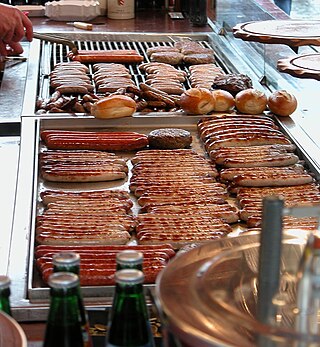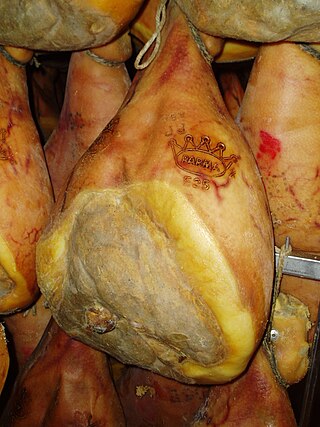
Cheddar cheese is a natural cheese that is relatively hard, off-white, and sometimes sharp-tasting. It originates from the English village of Cheddar in Somerset.

Mortadella is a large Italian sausage or luncheon meat made of finely hashed or ground cured pork, which incorporates at least 15% small cubes of pork fat. It is traditionally flavoured with black pepper grains, but modern versions can also contain pistachios or, less commonly, myrtle berries. The sausage is then cooked.

Newmarket is a market town and civil parish in the West Suffolk district of Suffolk, England. Located west of Bury St Edmunds and northeast of Cambridge. It is considered the birthplace and global centre of thoroughbred horse racing. It is a major local business cluster, with annual investment rivalling that of the Cambridge Science Park, the other major cluster in the region. It is the largest racehorse training centre in Britain, the largest racehorse breeding centre in the country, home to most major British horseracing institutions, and a key global centre for horse health. Two Classic races, and an additional three British Champions Series races are held at Newmarket every year. The town has had close royal connections since the time of James I, who built a palace there, and was also a base for Charles I, Charles II, and most monarchs since. Elizabeth II visited the town often to see her horses in training.

A pasty is a British baked pastry, a traditional variety of which is particularly associated with Cornwall, South West England, but has spread all over the British Isles, and elsewhere through the Cornish diaspora. It is made by placing an uncooked filling, typically meat and vegetables, in the middle of a flat shortcrust pastry circle, bringing the edges together in the middle, and crimping over the top to form a seal before baking.

Bratwurst is a type of German sausage made from pork or, less commonly, beef or veal. The name is derived from the Old High German Brätwurst, from brät-, finely chopped meat, and Wurst, sausage, although in modern German it is often associated with the verb braten, to pan fry or roast. Beef and veal are usually incorporated amongst a blend often including pork. Beef or veal is usual in halal and kosher Bratwurst sausages, which never include pork for religious reasons.

Cumberland sausage is a pork sausage that originated in the historic county of Cumberland, England, ceremonially part of Cumbria. It is traditionally very long, up to 50 centimetres, and sold rolled in a flat, circular coil, but within western Cumbria, it is more often served in long, curved lengths.

Prosciutto crudo, in English often shortened to prosciutto, is uncooked, unsmoked, and dry-cured ham. Prosciutto crudo is usually served thinly sliced.
Romanian cuisine is a diverse blend of different dishes from several traditions with which it has come into contact, but it also maintains its own character. It has been mainly influenced by Turkish but also a series of European cuisines in particular from the Balkan Peninsula and Hungarian cuisine as well as culinary elements stemming from the cuisines of Central Europe.

Thuringian sausage, or Thüringer Bratwurst in German is a unique sausage from the German state of Thuringia which has protected geographical indication status under European Union law.

The Melton Mowbray Pork Pie Association is a group of pork pie manufacturers in the Melton Mowbray area of England, UK. The association was set up in 1998 with the aim of helping to protect the Melton Mowbray pork pie recipe.

Galician cuisine refers to the typical dishes and ingredients found in the cuisine of the autonomous community of Galicia, Spain. These include shellfish, empanadas, polbo á feira, cheese queixo de tetilla, ribeiro and albariño wines, and orujo liquor. Similarly, to Asturian cuisine, Galician dishes have maintained several Celtic links, namely with different stews.

Lincolnshire sausages are a distinctive variety of pork sausage developed in and associated with the English county of Lincolnshire.
There are many geographically indicated foods of the United Kingdom. In British cuisine, there is a custom of naming foodstuffs with reference to their place of origin. However, there are other reasons for this practice; Scotch egg, which was invented in London and Dover sole which indicates where they were landed, for example.

Winter salami is a type of Hungarian salami produced according to a centuries-old tradition. Made from Mangalitsa pork and spices, winter salami is cured in cold air and smoked slowly. During the dry ripening process, a special noble-mold is formed on the casing surface.

Stornoway black pudding is a type of black pudding made in the Western Isles of Scotland.

Black pudding is a distinct regional type of blood sausage originating in the United Kingdom and Ireland. It is made from pork or occasionally beef blood, with pork fat or beef suet, and a cereal, usually oatmeal, oat groats, or barley groats. The high proportion of cereal, along with the use of certain herbs such as pennyroyal, serves to distinguish black pudding from blood sausages eaten in other parts of the world.
Sneem Black Pudding is a variety of black pudding produced in Sneem, County Kerry, Ireland.














